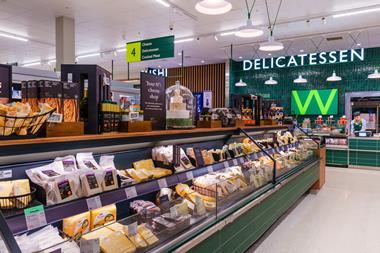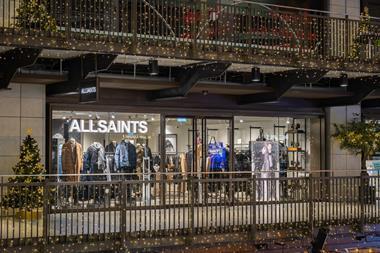Another day, another green supermarket. The sheer number of announcements that the big food retailers have put out over the past three years about eco-stores might be sufficient to make the uninformed imagine the UK’s retail carbon footprint is now so small as to be hardly worth bothering about.
Whether it’s solar panels, wood pellet burners, wind turbines or recycled materials, enough noise has been generated to create the impression that it’s job done and that perhaps it’s time to think about something else.
This is, of course, not just wrong, but wildly so. There are still only a handful of more sustainable supermarkets, with all the benefits that this should imply, in the UK and while things are changing we are still a long way from the goals that retailers have been setting themselves since the turn of the millennium.
It would, however, be equally unfair to imply that progress is not being made. Tesco’s latest green store, which opened in Manchester last week, is, as Tesco head of environmental construction Mark Sowter puts it, “another step in the right direction”.
Certainly, things are changing. Tesco started
on the green brick road in 2005 with a branch in
Diss, Norfolk, followed by another at Wick, in the Scottish Highlands a year later, and then two more in Swansea and Shrewsbury. Most of these stores came equipped with wind turbines and Wick quickly became a wood-framed showpiece. Yet while these stores might have afforded shoppers a glimpse of one possible future, the expense involved looked set to preclude a general roll-out.
However, the 52,000 sq ft (4,830 sq m) store in Manchester’s Cheetham Hill district, shows just how far things have come. From the outside you could actually be standing in front of any green supermarket. All the signs are there, from the two wind turbines twirling merrily on the roof, to the building’s German-sourced wood frame and cladding, giving the store the appearance of a supersize sauna.
Sowter is the first to admit that the wind turbines work more as an eco-pennant advertising Tesco’s green credentials than to serve any real economic or environmental purpose. The same is true of the two ATMs near the main entrance. These are located in a wood-clad structure, much like the sort of thing you see outside your local B&Q where it is usually billed as a playhouse. The planks have been applied to the structure to ensure that this area is in keeping with the rest of the building, according to Sowter.
That said, the bulk of the wooden exterior is functional rather than aesthetic and, presumably, more sustainable than the usual alternatives. Within the wooden walls, rockwool insulation – a material with low environmental impact – ensures the building conforms to the required standards.
The logo has also been thought about. In Wick, the decision was taken not to light the external Tesco sign as this consumes a lot of energy and the assumption was made that the 8,000 people who live in the town would probably be able to find the store. This approach has been ditched in Cheetham in favour of an LED-illuminated logo that certainly uses energy, but less than is usually the case.
Interestingly, there are no solar panels – which might look like an omission when set alongside previous eco-stores. Sowter says that following trials undertaken using banks of solar panels on the roof of the Swansea store, a decision was reached not to press ahead with this kind of energy generation for the time being. The reason was simple: at present, solar panels do not cut the mustard when the build cost of a new store is subject to bangs-for-your-buck scrutiny. The decision stands as evidence that Tesco’s previous eco-stores have been developed here into a green template where construction costs can be kept under control.
Sowter says that the store build at Cheetham Hill costs 10 per cent more than the price tag for an outlet of the same size using conventional methods. By any standards, this is a remarkable turnaround compared with just a couple of years ago when any mention of additional cost per square foot was quickly brushed aside on the basis that this was an investment for the future. The 10 per cent number is also close to that claimed by Asda when it unveiled its eco-store at Bootle, Merseyside, in October.
It all stands as a measure of how green store design, with all that this implies, is becoming the norm rather than the exception. Internally things are just as you might expect, but with a twist. Look up and there are the skylights, something that no self-respecting eco-store would be without, except that you can’t see through them. They are in fact sheets of polycarbonate, which Sowter says allows “50 per cent light penetration without the solar effect”.
He has a point. In other stores of this kind, the glass skylights are usually found on one side of a gable that stands proud of the roof and on a sunny day they may allow light into the interior, but they also have a tendency to act as unwanted heaters. This means the building requires additional cooling and uses additional energy to achieve this – a zero gain therefore as far as carbon emissions are concerned. The polycarbonate sheets are nothing flashy then, but a considered solution to a problem – an approach that characterises this second-generation eco-store.
The other major energy-saving features of this branch are the chillers and freezers. As in any other large-footprint supermarket, there are long aisles of these and as Sowter observes, in a normal store they could account for up to a third of total energy use. In such stores, the shopper modus operandi is to reach in and remove a product from open-topped or open-sided units. In Cheetham, the chiller units all have glass doors, meaning that the internal ambient temperature is more readily controlled with less need for continuous cooling.
There are of course a significant number of other small refinements that have been made to help improve this store’s energy efficiency and the majority of them are largely invisible. Which is rather the point about green stores. Tesco may have felt the need to wear its heart on its sleeve with the external windmills, but to all intents and purposes this is just another outlet that happens to be better at using energy.
It’s worth noting too that Tesco has been on a tour of Asda’s green store at Bootle, a favour that has been reciprocated. So who knows? It may just be that the green rallying flag is sufficiently all-encompassing to overcome the intense rivalries that exist between the big supermarkets. Pretty unlikely though.
See more pictures of Tesco's latest green supermarket on our Stores Image Gallery


























No comments yet